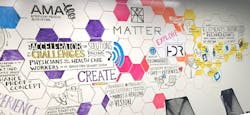Healthcare design partnership asks: What about the doctor?
I cannot tell you how many times I have said over the last several years that yes, at HDR, our goal is to understand our client, understand their communities, and to develop a consistent and meaningful patient experience. This experience will embody the vision of our clients and will fulfill the unique needs of the patient population for whom they serve. And I absolutely mean it, every single time.
That said, we also need to consider who influences the patient experience, and howtheir experience affects overall patient satisfaction. Where better to start than with the physician?
The physician culture has drastically changed over the last several years. A survey by the Physicians Foundation found that the majority feel negatively about their profession. As noted in a recent Time article, “Too much paperwork and regulations, plus the burden of defensive medicine, are the strongest contributors to this bleak outlook. These erode the doctor-patient relationship and the clinical autonomy that doctors have always cherished. What once seemed a higher calling increasingly feels like an assembly-line job.”
To address the shift in physician culture, how can we assess the culture of the traditional practice, including physicians’ relationships with their patients, and build solutions toward sustainable physician practices?
Here’s what HDR is doing to answer that question.
Last summer, we were approached by the American Medical Association (AMA), an organization dedicated to promoting the art and science of medicine and the betterment of public health. Their challenge to us: “Can HDR design a spatial experience that enhances how physicians practice medicine in the future?” and I hope this, in turn, will continue to improve patient experiences. As a leading voice in healthcare design, and moreover, an organization that wants to make a difference through innovation, we agreed to partner with the AMA to research, innovate, design, and create this experience. That’s right, we are actually going to prototype the group’s ideas.
We have just begun our work together, but we will be sharing the story with you as we go. Early design principles for the space have included a focus on collaboration, testing, and learning, all driven by an engaging user experience. This will evolve from low-fidelity conference space to a high-fidelity immersive environment over the span of the project. This exploration will influence our understanding of how physicians will practice in the future—and ultimately, how our designs will support them. On this journey we will:
- Research the current and future physician practice
- Hypothesize what the future might look like
- Refine that future through participation and feedback
- Build a prototype of our ideas
- Learn from successes and failures
- Share what we learn toward design approaches for a sustainable physician future
Stay tuned, more to come.
Learn more about the AMA Interaction Studio at MATTER on our website.
About the Author: Abbie Clary is a Principal and Healthcare Director, Central Region, based in HDR's Chicago office. Her passion at work is community health, which led her to launching HDR’s Community Health Initiative in 2011, a program focused on building healthier communities through facility design. More on Clary.
